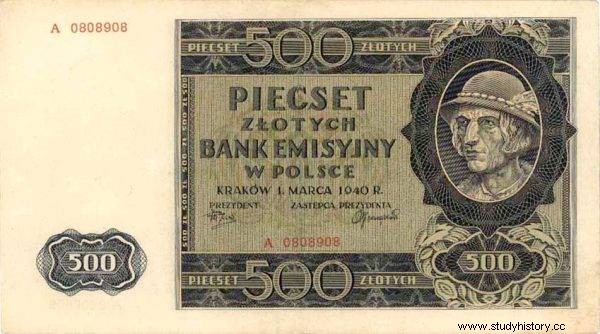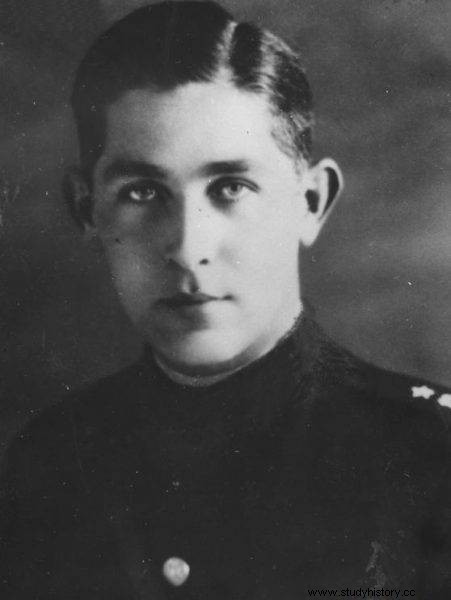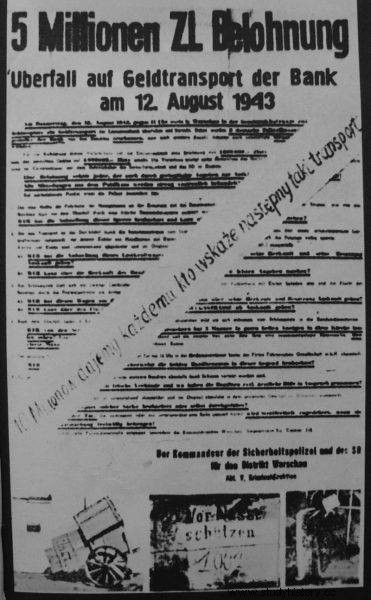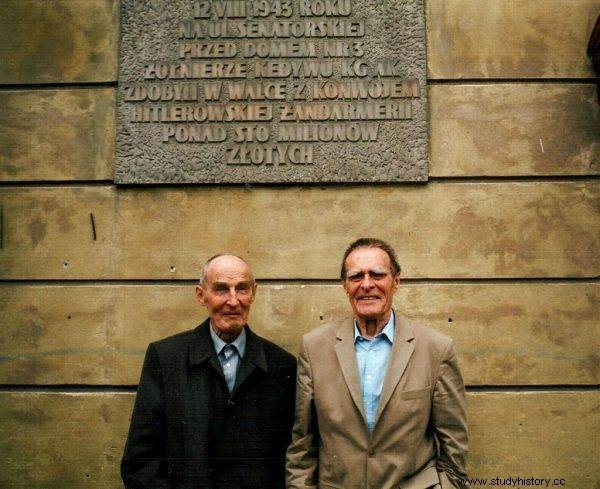In 1943, as a result of a daring action, the Home Army soldiers captured a van full of money. One hundred million zlotys! Preparations for the so-called Góral's campaign lasted one and a half years, its execution only a few minutes. It was a "lace job". Probably the best prepared and carried out operation in the history of the Home Army.
German occupation. In 1942, the Union of Armed Struggle was renamed the Home Army. The anti-Nazi underground is growing, but money is still lacking. And these are needed - for weapons, clothes, the operation of saboteurs and couriers. This is how the idea of an attack on a bank van was born. The idea arose from the conversations between the Home Army commander - General Stefan "Grot" Rowecki with captain Emil Kumor - "Krzysie".
"Highlanders" up for grabs
After the September defeat, every aspect of the country's social and economic life came under German control, including the banking system. The Germans decided to establish the Bank of Issue, which was to issue the occupying zloty. Its headquarters was in Krakow, but the money was printed, among others in Warsaw - among them, the so-called highlanders, i.e. 500 zloty banknotes with the image of a highlander on the front. Hence the name of the action, which many historians considered the best prepared and carried out in the history of the Polish underground during the Second World War.

Money was printed, among others in Warsaw - among them, the so-called highlanders, i.e. 500 zlotys banknotes with the image of a highlander on the front.
The task was entrusted to the Special Division of the Home Army Headquarters - "Osa". The preparations for the attack lasted 14 months. Despite the fact that in the meantime, the underground suffered severe losses, incl. as a result of a mishap during the wedding ceremony of one of the soldiers. The Germans arrested most of the saboteurs of "Osa", and Grot-Rowecki himself was also taken prisoner, but the preparations for the attack continued.
Two Michaels
The key to success was knowing the route of the van with the money that was to be delivered from Warsaw to the bank's headquarters in Krakow. The Germans were well aware of the threat. The route of the van's course from Bielańska Street, where the bank's Warsaw headquarters was located, to the Eastern Railway Station was kept secret every time. Therefore, the unit responsible for the action attempted to recruit bank employees.
It was successful, Ferdynand Żyła (pseudonym "Michał I") and Jan Wołoszyn ("Michał II") were persuaded to cooperate. Although the Germans made sure that the exact dates of the cash transport were not known to the employees, the secret did not apply to "Michael II". The day before his departure, this one found out about the transport.
In view of such knowledge, the only option left for the Home Army saboteurs was to prepare an ambush. There were two alternative routes for the van. One of them had to be prevented and a trap should be set on the other. This was also done. As the wagon with the "highlanders" could reach the Wschodni Railway Station only along Senatorska and Miodowa Streets to Krakowskie Przedmieście and Plac Zamkowy, and then through Nowy Zjazd to the Kierbedzia Bridge or Senatorska to Plac Zamkowy and further, as in the first variant, the saboteurs arranged fictitious road works, thus blocking Miodowa Street. Thus, the Germans only had one cash transport route left.
False start
The action, however, started with a false start. On August 5, 1943, 43 soldiers and 2 female liaison officers were to take part in the attack on the wagon. However, three soldiers serving sten, i.e. British submachine guns used by the Home Army, did not show up. Therefore, ultimately the operation commander Jerzy Kleczkowski, pseud. "Jurek" decided to cancel the task, especially since the Germans became suspicious after the participants of the action cut the telephone cables connecting the issuing bank with the Gestapo and the police station in the sewer wells.

Jerzy Kleczkowski
As a result, the money wagon started moving, but with a very strong military escort. Earlier, an alarm was triggered at a bank branch. The bank guard was broken up, and soon the army arrived with machine guns.
"Auntie is away"
In the second installment of the action, Kleczkowski ps. "Jurek" and Roman Marian Kiźny, commanding the unit of "Pola" dedicated to supporting "Osa" in this action, gave up cutting cables. On August 11, 1943, saboteurs received a telephone report from Michael II - a bank clerk cooperating with the Home Army. The report was: aunt has left . This meant that another shipment of cash would leave the bank the next day. The next day, another call from the bank at 9 am meant the transport would start an hour later.
Several dozen of Home Army saboteurs were already there - that is, on Senatorska Street, which was designated the site of the attack, mainly because it was narrow. It made it impossible for the blocked van to maneuver. The street was surrounded by cover patrols. Home Army soldiers hid from, among others in a truck parked on the street that blocked the passage, in a vegetable store on the street, in the staircase of one of the tenement houses. At 10:17 a truck full of money with an escort entered the narrow Senatorska Street , turning in front of the barriers on Miodowa Street, behind which alleged road works were taking place.
After entering Senatorska Street, the convoy slowed down to avoid the truck in which the Home Army soldiers were hidden. As soon as the van started moving, another obstacle arose in front of him - a cart with crates full of vegetables and fruit, which the attackers had deliberately advanced. The bank truck braked sharply, found itself in a trap, right next to the truck in which the Home Army soldiers were hidden.

A German poster offering a reward of PLN 5 million for identifying the perpetrators of the robbery with a strip attached by the Home Army with the text "PLN 10 million to anyone who indicates the next such transport"
As soon as this happened, after the signal to attack, a barrage of shells rained down on the German convoy. At the same time, a car of the bodyguards was attacked from hiding places along the street. The Germans did not have time to react. After the first series, the saboteurs jumped to the car, throwing the dead and wounded out of it. During the operations - unexpectedly - a Wehrmacht officer passing by the Castle Square appeared on the spot. He managed to fire a series against the bombers, but that didn't change the situation. The officer was shot dead by the Home Army betting the area. Two German policemen also reacted to the sound of shots and screams. They were coming from Bruhl's palace when the bullets caught them.
The whole action lasted less than 3 minutes. Six German escort soldiers and an officer were killed, as well as three bank employees. On the side of the Home Army, the losses were minimal. Two soldiers were lightly injured. The underground was enriched by over 100 million occupation zlotys in less than 3 minutes. The Germans were furious. Posters promising a high reward (PLN 1 million for identifying the perpetrators, PLN 5 million for helping to recover money) were hung all over the city.
Zygmunt witnessed
The Underground quickly reacted to the invader's offer. The Nazi authorities were flooded with a wave of false denunciations that confused the enemy and directed the investigation to false leads. This has proved to be extremely effective. The Germans were not sure if the attack was behind the Home Army, or if it was simply a robbery, so they eventually refrained from repressing civilians.

The two last surviving (July 2013) participants of the action "Góral" Tadeusz (on the left) and Andrzej Żupański under the memorial plaque in the place of the action
At the same time, the Home Army soldiers also made fun of the enemy. Therefore, the posters have some notes suggesting even bigger prizes - 10 million - waiting for those who will indicate the dates and routes of the next convoys. On the other hand, among the letters to the occupation authorities there was also the correspondence of the witness who declared that he had an excellent view of the whole incident thanks to the fact that he had looked from above. The letter was signed ... Sigismund III Vasa.
